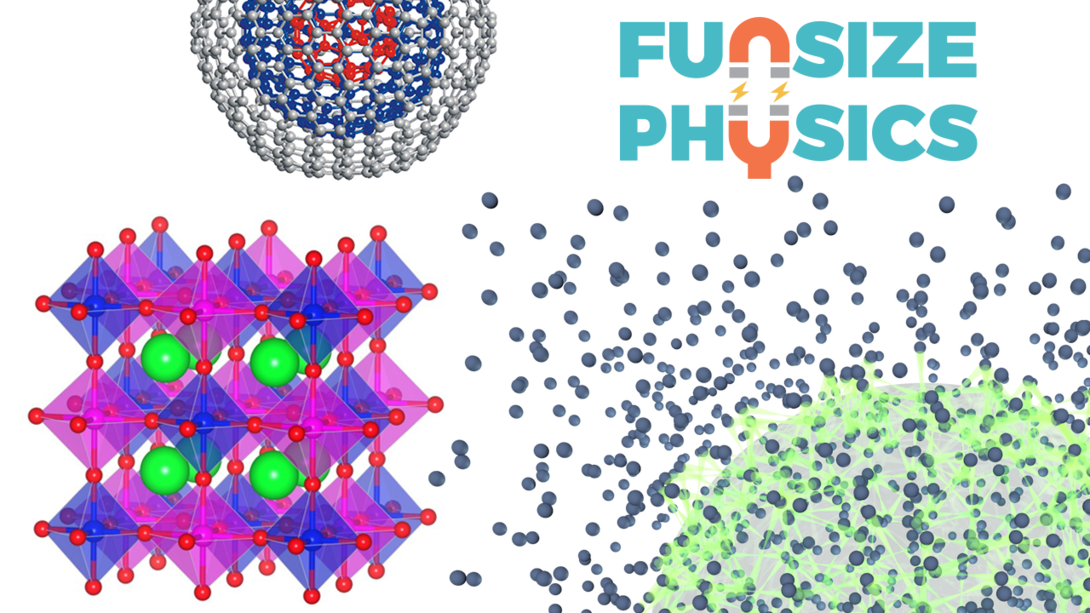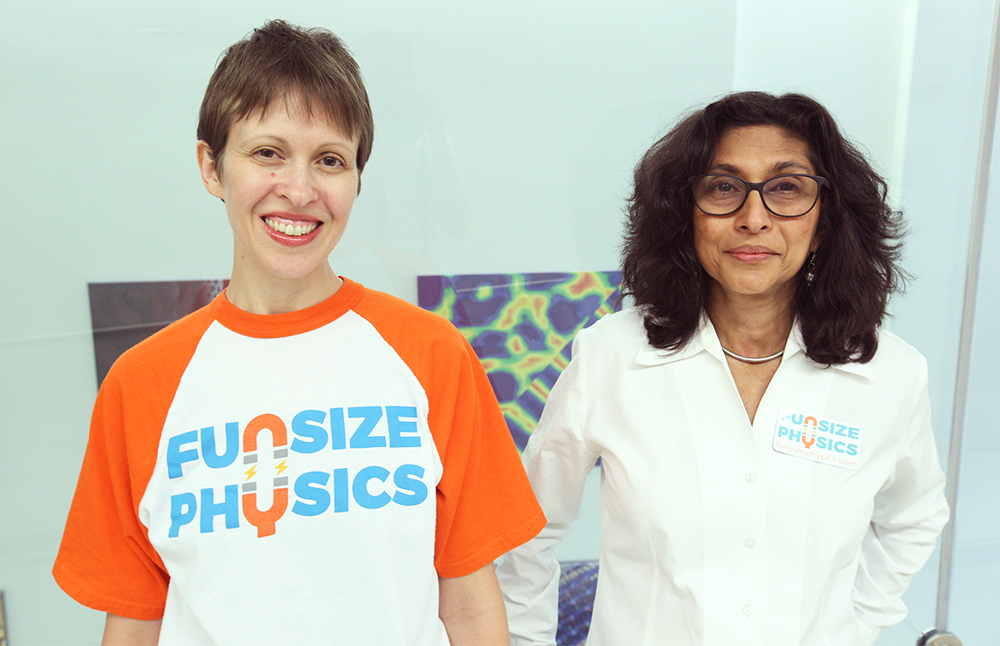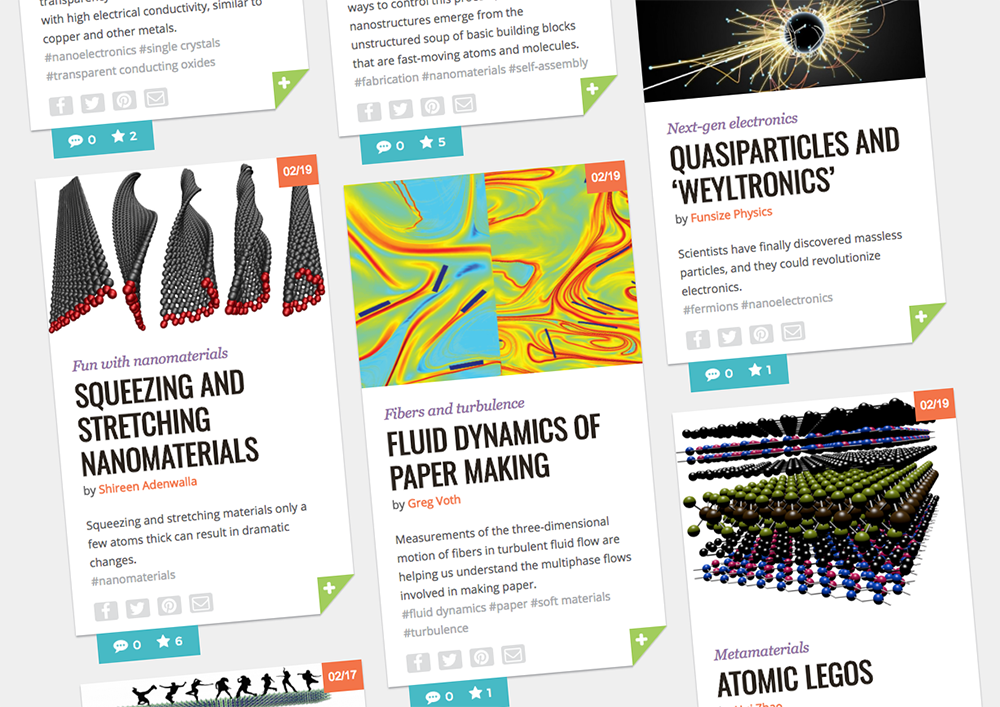
Funsize Physics is not responsible for any minds that are blown.
That tongue-in-cheek waiver, which immediately greets visitors to the website Funsize Physics, fittingly manages to capture both its spirit and mission in one short sentence.
Launched by the University of Nebraska-Lincoln with support from the National Science Foundation, the website features brief highlights of condensed-matter physics research and classroom activities written by NSF-funded researchers from across the United States.
“When you get atoms and molecules together, all this weird stuff starts to happen,” said Jocelyn Bosley, the site’s curator. “That’s what I think is really cool – all of these weird effects that happen when you get them interacting really closely like that.”
That, in a nano-shell, is condensed-matter physics: the cooperative behavior of atoms or molecules from which strange and exotic phenomena emerge. The interactions that can turn a liquid into the “anti-molasses” form of matter known as superfluid, for instance. Or the atomic structure of a material that allows an inkjet printer to churn out solar cells. Or the assembly of carbon-based “onions” small enough to ferry therapeutic drugs through a bloodstream.
Those phenomena, and many others, get their due on Funsize Physics in the form of easy-to-read posts that favor approachability over technicality.
“People haven’t heard of (the field) as much, because I think maybe it’s not as sexy as astronomy or high-energy physics,” said Shireen Adenwalla, the Nebraska professor of physics and astronomy who conceived the website. “But condensed-matter physics is very beautiful. I don’t think people know that, and I think it’s true that condensed-matter physics has been disregarded. So we decided we wanted to start a website, and we wanted many people to contribute.”
The website, which went live in 2016, recently received another round of funding from the National Science Foundation. Since the launch, researchers at more than 20 institutions – ranging from the University of Southern California and Ohio State University to North Carolina State University and the University of Pittsburgh – have contributed.
Most have come directly from the field of condensed-matter physics, though Adenwalla welcomes anyone funded by the NSF’s Division of Materials Research – chemists, engineers, biologists – to submit entries.
“We feel like this is very important, because I think we’re not good at trumpeting what we do,” Adenwalla said. “I don’t mean in the sense of showing off; I mean in the sense of letting people know what we’re doing. This is public money: your taxes, my taxes. How do we let you know not only that it’s beautiful science, but (also that) it leads to wonderful things?”
Apply here, inspire there
To reach that goal, Adenwalla and Bosley first had to answer one of the most fundamental but often daunting questions facing any communicator: Who’s the audience?
Knowing that they wanted to reach anyone without a physics background but with an interest in the field, the pair initially gave little guidance on how much breadth or depth the submissions should encompass. But after receiving a wide range of submissions – everything from dense, lengthy write-ups to equations with little text explaining them – Adenwalla and Bosley reconsidered their approach.

“If you just tell the contributors to write for a general audience, they have no idea what that audience knows or doesn’t know,” said Bosley, assistant director for education and outreach at the Nebraska Materials Research Science and Engineering Center. “And it’s fair enough, because that’s so vague. But when we told them, ‘Write it so that a bright, interested middle-schooler could understand most of it,’ then they would go, ‘Oh! OK.’
“It’s not that those are the only people we want to reach, but there’s a lot of stuff that kids in middle school learn that adults have forgotten, so I don’t think you’re missing the mark too widely with the general public if you go with that.”
Adenwalla and Bosley also had to decide which aspects of the research to highlight. The fact that condensed-matter physics has spawned countless technologies – and continues to drive innovation across virtually every industry – makes a compelling case for covering its applications, which the site does.
“Condensed-matter physics is what gave us transistors. And without silicon transistors, what would you be carrying around?” Adenwalla asked. “You’d be carrying around a chest, not a laptop or an iPad or an iPhone.”
Yet concentrating solely on applications, Adenwalla said, risks diminishing the sense of awe that first attracted her – and many researchers – to the field. So the website liberally incorporates metaphor, historical context, imagery and video to help stimulate the curiosity of someone who’s never encountered the term “skyrmion” or “spintronics” or “quantum vortices.”
“Sometimes there’s this dynamic where people are trying to justify (the research) in terms of practical benefits, and then people feed into that by deciding whether they think that’s sufficient or not,” Bosley said. “It just makes the whole dialogue about that, when that might be part of it, but there’s more to it than that.”
‘Not so different’
Though Adenwalla described herself as “not very good” at explaining physics to lay audiences, she conceded that she has improved since undertaking the Funsize Physics project. And that, said Bosley, represents the website’s other primary objective.
“I think there was a sense (among some contributors) – much like the sense people have about other skills, like writing and speaking – that you’re just innately good at it or not,” Bosley said. “And if you’re not, then you’re off the hook. You don’t have to try to do it. So I think that was a problem.
“We want to encourage them to think, ‘Just because I don’t know how to do this doesn’t mean I can’t learn how to do it.’ I think that what excites physicists about their work, and what excites the public about their work, is not so different. It’s just a matter of (surmounting) the communication barrier between them.”

Crafting a post that balances information with brevity, nuance with comprehension and accuracy with readability can test even the most conscientious writer, Adenwalla said. But the site’s contributors have reported learning a lot that they plan to apply going forward, she said, and most have found it more charm than chore.
“I do think, overwhelmingly, that they are surprised by how painless and even fun the process is,” Bosley said. “They actually have a good time and get into it. People don’t (always) realize that they actually get something out of it, too, until they go through the process. Then they’re like, ‘Hey, I liked that. That was actually fun for me, too.’”
“It’s not like, ‘Eat your kale! You’d better do it!’” Adenwalla said. “We want to facilitate the urge that I think many people have: to tell people what science they’re doing. Everyone likes to talk about what they do, what they’re passionate about. Hopefully this encourages it.”







